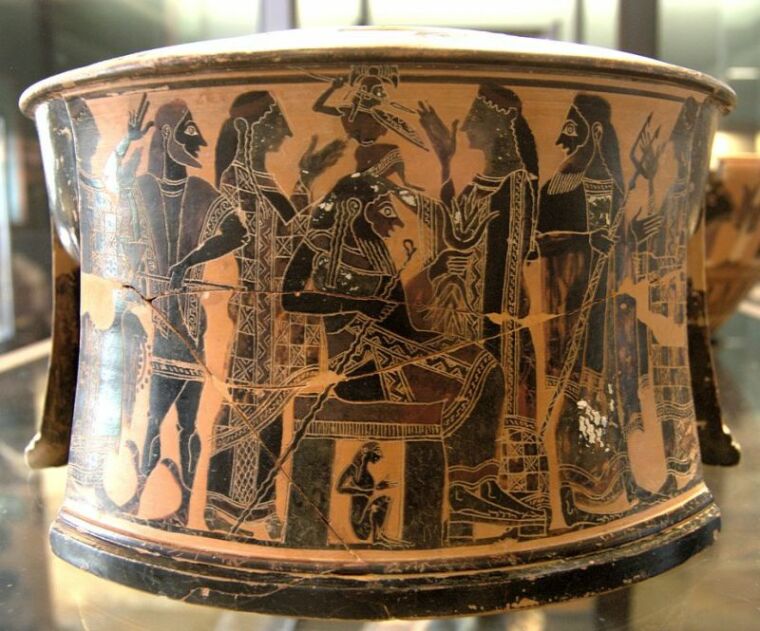Ancient pottery shard depicting birth of Athena found in Biblical village in Israel

An ancient Italian vase shard depicting the birth of the Greek goddess Athena was unearthed at an Israeli archaeological site that was once known as the biblical kingdom of Geshur.
Israeli archaeologists discovered the artifact at e-Tell, which is among the leading contenders to be the original site of the biblical town Bethsaida, where Jesus was believed to have performed miracles.
The "richly decorated" vase is approximately 2,300 years old and depicts the birth of Athena, the Greek goddess of war and wisdom.
There was a lively debate about what was exactly depicted in the shard after the Bethsaida Excavations Project uncovered it at the dig site north of the Sea of Galilee back in 2016.
"Some saw a figure seated upon a seat with another figure next to it. Others saw something erotic," said Dr. Rami Arav, the project director and a professor of Religion and Philosophy at the University of Nebraska in Omaha. "But I said, 'No, it can't be erotic. It must be something else," he told the Times of Israel.
In the scene, Athena springs to life fully formed from the head of her father Zeus, as the nymph Dione and goddess Aphrodite look on.
According to Greek mythology, Athena's pregnant mother was swallowed by Zeus after an oracle warned him that the offspring might bring him harm. His action resulted in a bad headache, prompting his son Hephaestus to split his father's head open to relieve the pressure, whereupon Athena emerged.
While the vase was discovered several years ago, experts were only able to decipher the scene recently with the use of imaging software.
Times of Israel noted that the scene is a rare replica of an image found in the eastern pediment of the Parthenon in Athens, Greece.
It is still not known how the artifact made its way to Geshur, and potentially to Bethsaida. Experts noted that the only other known surviving copy of the Parthenon scene was found in Greece, not far from Athens.
"Few buildings in the history of architecture have been as ferociously ideological in design and decoration as the Parthenon," said Daniel Mendelsohn, a professor of humanities at Bard College.
"Everything about it...bespeaks a desire on the part of the builders to underscore Athenian political, military and ideological supremacy," he added.
Arav explained that the shard could be considered as a contemporary knockoff of "Apulian pottery," a style of pottery painting that originated in southern Italy during the seventh century B.C. He further noted that the Bethsaida copy of the Parthenon scene probably originated from the Phoenician Coast.
Other important discoveries have been made at the e-Tell site, which Arav has excavated since 1987 with the Consortium of the Bethsaida Excavations Project.
A Bull Stele that stood on top of an altar at the entrance of Geshur, which was discovered in 1996, is currently on display at the Israel Museum.
In 2014, the team found a rare Roman coin issued in 85 A.D. by Agrippa II. The coin bears the phrase "Judea Capta," commemorating the victory of the Romans against the Jewish rebels and the destruction of the temple in Jerusalem.
 Christians don't have to affirm transgenderism, but they can’t express that view at work: tribunal
Christians don't have to affirm transgenderism, but they can’t express that view at work: tribunal Archaeology discovery: Medieval Christian prayer beads found on Holy Island
Archaeology discovery: Medieval Christian prayer beads found on Holy Island Presbyterian Church in America votes to leave National Association of Evangelicals
Presbyterian Church in America votes to leave National Association of Evangelicals Over 50 killed in 'vile and satanic' attack at Nigerian church on Pentecost Sunday
Over 50 killed in 'vile and satanic' attack at Nigerian church on Pentecost Sunday Ukrainian Orthodox Church severs ties with Moscow over Patriarch Kirill's support for Putin's war
Ukrainian Orthodox Church severs ties with Moscow over Patriarch Kirill's support for Putin's war Islamic State kills 20 Nigerian Christians as revenge for US airstrike
Islamic State kills 20 Nigerian Christians as revenge for US airstrike Man who served 33 years in prison for murder leads inmates to Christ
Man who served 33 years in prison for murder leads inmates to Christ


 Nigerian student beaten to death, body burned over ‘blasphemous’ WhatsApp message
Nigerian student beaten to death, body burned over ‘blasphemous’ WhatsApp message 'A new low': World reacts after Hong Kong arrests 90-year-old Cardinal Joseph Zen
'A new low': World reacts after Hong Kong arrests 90-year-old Cardinal Joseph Zen Iran sentences Christian man to 10 years in prison for hosting house church worship gathering
Iran sentences Christian man to 10 years in prison for hosting house church worship gathering French Guyana: Pastor shot dead, church set on fire after meeting delegation of Evangelicals
French Guyana: Pastor shot dead, church set on fire after meeting delegation of Evangelicals ‘Talking Jesus’ report finds only 6% of UK adults identify as practicing Christians
‘Talking Jesus’ report finds only 6% of UK adults identify as practicing Christians Mission Eurasia ministry center blown up in Ukraine, hundreds of Bibles destroyed: 'God will provide'
Mission Eurasia ministry center blown up in Ukraine, hundreds of Bibles destroyed: 'God will provide' Church holds service for first time after ISIS desecrated it 8 years ago
Church holds service for first time after ISIS desecrated it 8 years ago Burger King apologizes for 'offensive campaign' using Jesus' words at the Last Supper
Burger King apologizes for 'offensive campaign' using Jesus' words at the Last Supper Uganda: Muslims abduct teacher, burn him inside mosque for praying in Christ’s name
Uganda: Muslims abduct teacher, burn him inside mosque for praying in Christ’s name